I want to tell you about possibly the best way to improve your tai chi: learn one of the tai chi weapons forms. Each tai chi weapon teaches a different way to balance, generate force, move, and hold your posture, all of which translate back into improving your open-hand form.
There are eight primary tai chi weapons forms that originate from infantry, cavalry, officer, and courtesan training. All tai chi styles use the sword, broadsword, spear, and long pole. Some styles train additional forms like double swords, fan, and halberd (guan dao).
Tai chi weapons forms are an incredibly beautiful, fun, and are a way to practice some of the core principles of tai chi. They are usually introduced after progress has been made in the open-hand form. While you do not have to know an open-hand form to begin a weapon form, knowledge from the open-hand form speaks directly to the movements of all the weapons.
Here are the forms. Then let’s dig a little deeper into the principle weapons and share some super-cool videos of masters in action to get you motivated to get started. Then, almost everything you need can be found on Amazon if you search for specific weapons or resources.
What are the Chinese Weapons for Martial Arts?
There are considered to be 18 Chinese martial arts weapons which has been referenced in multiple texts. Did you think you were going to get a simple answer? This is a Chinese martial art we are talking about with five main styles and a long history.
“…the weapons for warfare have thirty six kinds with the bow as the first weapon. The weapons for martial arts have eighteen kinds with the bow as the first weapon, too.”
Tang Shunzhi (1507-1560), Ming Dynasty General who fought against Japanese pirates. Wu Bian (Treatise on Military Affairs)
“The Eighteen Weapons are bow, crossbow, spear, saber, sword, throwing spear, shield, axe, deer-horn knives, halberd, whip, mace, talon, staff, fork, rake, rope and lariat and open hand (bai da). Bai da is the ultimate martial skill as it does not employ any weapons.”
Xie Zhaozhi – Volume Five of his book Wu Za Zu (Five Varied Groups)
While 18 is generally considered to be the number of weapon forms, there is an ever-ensuing debate over which weapons should be included. Here is a rough overview:
Tai Chi Weapons Based on the Three Primary Sources
| Wuzazu Version | Water Margin Version | Modern List |
| Ancient style spear | Ancient style spear | Axe |
| Axe | Axe | Bar mace |
| Bar mace | Bar mace | Blade |
| Barehanded | Bow | Club |
| Bow | Chain | Dagger halberd |
| Crossbow | Club | Double-edged sword |
| Dagger halberd | Crossbow | Great axe |
| Double-edged sword | Dagger axe | Hook sword |
| Great axe | Dagger halberd | Long spear |
| Pole pick | Firearm | Mace |
| Rake | Great axe | Meteor hammer |
| Rope | Mace | Pole pick |
| Round bar mace or iron whip | Pole pick | Ranseur |
| Shield | Round bar mace or iron whip | Round bar mace or iron whip |
| Single-edged sword | Shield | Spear |
| Spear | Spear | Staff |
| Spiked Mace | Sword | Tonfa |
| Trident | Trident | Trident |
These lists vary based on when in time they were used and what part of the country (or foreign countries) they were fighting in. It’s interesting but really not worth the debate. Here is a better question for our purposes:
Which tai chi weapon forms are currently practiced?
Now we are getting somewhere. There are eight principle tai chi weapons. More important than arguing which weapons there are or how many, is knowing why they were chosen and how they are grouped. Think of weapons training as an out-of-the-box experiment to get better overall at tai chi by isolating movements and practicing in a new way.
1. Tai Chi Straight Sword – Jian (劍)
The energy of the sword requires you to be completely balanced. It is tested by issuing power into the sword in high one-legged postures and low stances. New students of the sword typically have all of their focus on the sword itself and forget about the other side of the body. This is natural and expected until the choreography is remembered. However, in order to issue energy into the sword, an equal amount of effort has to be delivered with the opposite hand, often in the opposite direction. Opening the chest and issuing force in different directions teaches balance.
The history, beauty, and complexity of the straight sword form is a topic all on its own so we wrote about it here. We also put together a have-to-know article if you are looking to buy one to start or continue practicing the sword.
2. Tai Chi Broadsword or Sabre – Dao (刀)
Tai chi broadswords are a bit shorter than the straight sword. They start off straight at the hilt, curve at the top, and are sharp on only one edge. They weigh 5-10 pounds on average. The broadsword form is shorter and more energetic. The weight of the sword, quick movements, and spins develop physical fitness, wrist strength, and flexibility, especially to the joints of the upper body. We get more questions about the tai chi broadsword because there are really unique ways it improves your tai chi and internal strength. There are also some crucial things to know before you buy one.
3. Tai Chi Spear – Qiang (槍)
Tai chi spears are about seven feet long, are made of wax wood, and have a spear head trimmed with horse hair. The spear form teaches twisting and suppleness and allows us to practice extending energy outside of the body. This weapon provides a lot of feedback and can be difficult to keep a hold of so there is an aspect of amassing power with a modicum of restraint.
Here is what to know if you are looking for a tai chi spear to buy and why this might be the best weapon for anyone to start practicing.
4. Tai Chi Long Pole – Dagan (大桿)
The tai chi long pole length can vary from 8 to well over 12 feet. Long poles are wax wood and the thickness increases tremendously towards the hilt and can be 2-3 inches in diameter. The pole form tests and increases the strength of the stance and exercises and strengthens the spine. It’s not the most common martial arts weapon so read this to learn about the important aspects of practice and this to find out what you need to consider when buying a long pole.
5. Tai Chi Double Straight Sword – Shuang Jian ((双剑)
The tai chi double straight sword is less common than the single sword form. Like the single sword form balance and correct power is obtained from an equal relationship of power and extension of both hands. The double sword form ands a greater element of difficulty and learning to be able to more both swords correctly.
6. Tai Chi Double Broadsword – Shuang Dao (双刀)
Like the double straight sword, the tai chi double broadsword is less common but further develops the teaching of the singe broadsword form. The hands in the single form spiral both in the same direction and opposite direction and issuing of energy in both swords occurs simultaneously.
7. Tai Chi Reclining Moon Blade – Guandao (关刀)
The guandao is a broadsword blade mounted on top of a pole. Typically there is a feather, hair or a flag tied to the back of the blade and some guandaos have a secondary smaller blade on the back. The guandao form combines movements such as spirals from the spear form, long strikes from the long pole form, and hacks down from the broadsword form. In English it could be considered a halberd and is known as the reclining moon blade but is known by most practitioners by its Chinese name, guandao. It was named after it’s inventor or at least the person who popularized its use, General Guan Yu.
8. Tai Chi Fan – Shanzi (扇子)
The tai chi fan weapon form is most known for its beauty and was trained as a weapon that could commonly be carried. Fan weapons could had blades and knives but the form emphasizes and teaches hidden movements, hidden movements and deception. The tai chi fan is a beautiful form. Here is some essential fan knowledge with video examples.
Six Reasons Why You Should Learn a Tai Chi Weapons Form
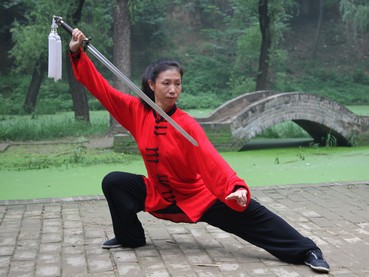
Let’s face it, I can see why most people are on the fence or may not be interested in learning a weapons form. With regular tai chi, you don’t need any equipment, there are a lot of people to practice with, you may only be interested in the health benefits, and learning a weapon might seem like a useless martial art. Besides, isn’t weapon training a form of kung fu?
Yes you do need to buy a weapon and learn an additional form but it is so worthwhile. But health benefits are as great in the weapons form because they can be more physical, they open up and improve your posture, and challenge your balance to make it better. Kung fu does use weapons but so does tai chi and the other internal arts. Why bother? Here are six reasons why you should study tai chi weapons:
When was the last time you resorted to using a 7 foot spear to settle a dispute? Or, do you think you would feel safer if your double-edge sword skills were up to snuff? Ridiculous, I know. Yet we study an art form that continues to teach ye-olde weapons forms.
1) A weapon gives you tangible, reliable feedback
I love the word “implement” rather than “weapon” to describe this group of tools. Tai chi weapons serve as feedback devices to let us know if we are moving and using energy correctly. This really isn’t possible in the open-hand forms. If you leaning over in the ball/sphere form, your back hurts. If you issue into the pole or spear and your weight doesn’t stay low in the body, it doesn’t shake. If you issue into a straight sword with less energy that goes into the opposite hand, the end of the sword barely quivers. Immediate, tangible feedback that uncovers bad posture and disconnected movement.
2) A weapon teaches how to extend your energy out past your physical body
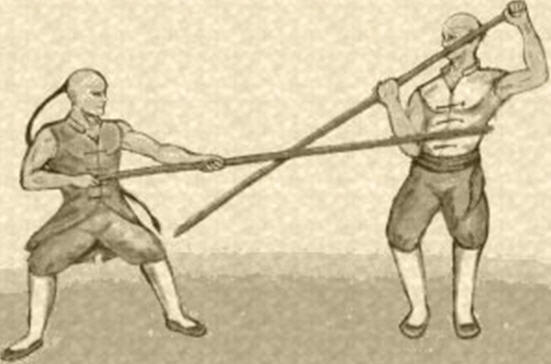
The material of each weapon is responsive. It shakes, quivers, snaps, or rings. When you move correctly (from the center and with a balanced body) energy travels out to the tip or to the edge of the implement. By taking our focus a few feet past our body we are introduced to a greater extension of our power. The alchemy people argue that our energy extends out past our skin. This esoteric ideas become easier to grasp when you are manipulating a physical object. Push hands or the open-hand forms puts its focus on energy traveling out to the hands which is great. However, if you study weapons you can shift your energy and focus out to a large area of influence.
3) Weapons help us understand how to separate heavy and light chi
We talk about moving from the center but the actual separation of lightness into the upper body and heaviness into the lower body is more easily understood if you are manipulating something with weight. You must keep your weight low and your upper body relatively relaxed so that you do fall over or lose your balance.
4) Weapons isolate individual energies
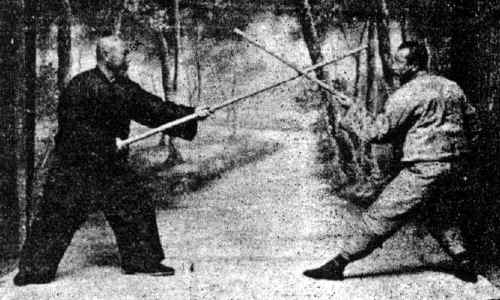
Tai chi weapons practice isolates specific energies in the same way that a musician isolate specific notes in a phrase. We isolate these energies to improve them and then re-integrate their use into the open-hand form. For example, the broadsword is centrifugal and sends the body in circles to power the single blade. Conversely, the spear spins portions of the body to create micro-cycles of energy. The straight sword teaches balance and equalization of power between the dominant (weapon) and non-dominant hand. Meanwhile, the dense pole teaches a summation of energy as the pole has to be powered from the heel through a correctly aligned posture in order to get the pole to respond correctly.
5) Weapons correctly transmit knowledge across time
Okay, pretend you have valuable health information to share. And, you want to make it available to people in the year 2514. What do you use? A floppy disk? Reel to reel? Will paper last outside of a museum? See what I am getting at? Yes, weapons have conveyed martial knowledge but I believe there is a more practical solution that was at hand. Someone wanted to teach energy work and the found objects they had and would likely be around (wax wood, bamboo, steal, etc). Their dimensions had been recorded and would largely stay the same. These “implements” would be a great way to convey their knowledge.
6) Tai chi weapons are fun! and connect us to tradition
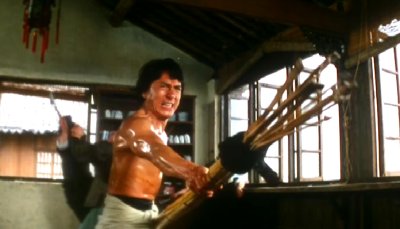
Let’s cut to the chase on this one. Tai Chi weapons forms are beautiful, fun, and you are participating in 2000 years of history. Be proud that you have chosen to align yourself with the thousands of practitioners over time who have worked to understand themselves better and align themselves with something greater. Plus, we don’t always have to be so serious. Let’s yell, jump in the air, and hit things!
Do we have to learn tai chi weapon forms to be good at tai chi?
I have met many practitioners with good skills who only do the open-hand form. So the overall answer is – no- weapons practice is not mandatory. However, there are huge benefits to learning a tai chi weapons form if you have access to teaching and interest.
On the other hand, there are also two good reasons to NOT learn a tai chi weapon form.
1) You don’t have a teacher. Knowledgeable teachers who both know the open-hand and weapon forms are not that common. There are many more teachers who only know or teach the open-hand form. This can be because they don’t have a teacher, space requirements, or they don’t have a large number of the weapons. Totally fine. If you are a teacher, you don’t have to teach them. If you don’t have a teacher that teachers the weapon forms, you get a pass.
2) You have low energy. Due to age, illness such as chronic fatigue, or low physical fitness, weapons might not be right for you. You will be waving around something heavy, will be outside most likely when it gets hot and cold, and the lower postures can be difficult. That being said, weapons quickly give you strength, stamina, and flexibility. So, if you want to become more physical and mobile, don’t avoid them.
Should I learn all the weapons forms?
I am going to begin by making the argument that the number of forms you learn depends on your interest and ability to remember. One thing that I love about tai chi is that you can accomplish so much by learning a single long form. I was part of another tradition for a while where there were 13 forms that we were required to learn. I spent so much energy memorizing patterns of movements. When I moved into the brown-belt material which was about 5-7 forms in, I started forgetting some of the first forms. I could not get to a deep level in that art and felt that it was my fault. The truth is that I was spending too much time learning when to turn right and left.
It’s good to stress the brain and learn new patterns. If you are spending more time reviewing and memorizing than you practicing and improving, you may have become a forms junky. So it is up to you to decide how many forms can you learn this lifetime to improve continually. I personally know and practice four weapon forms with 20 years under my belt and don’t plan to learn any more. Even if you are new, weapons forms are really fun and one of enjoyment is one of the top reasons to practice tai chi.
Tai Chi weapons forms teach us skills that cannot easily be accomplished with the open-hand form or any other fitness regime.
I’m in! How do I get started?
Training tai chi weapons is a fun, athletic, out-of-the-box experiment of your memory, internal, and external skills. It also keeps us not-so-serious because they are so fun. Have a look around the internet at different weapons if you are interested. There are some really good providers who are weapons nerds and love to answer questions. It is very important you know a few things before purchasing though. We wrote about how to buy tai chi weapons and where to buy them online on our Best-Of page. Go there to find out what to look for and how to get the best price.


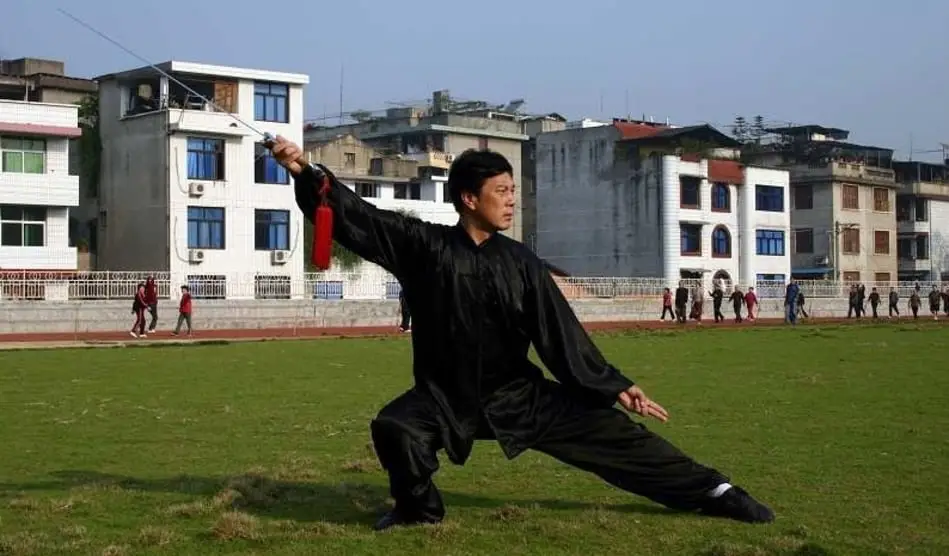
I am not sure what family of tai ji quan you practice but I do Chen style and I have also learned 2 weapons and have found that the weapons forms where not more difficult than the open hand forms…especially the chen style er lu or part 2, sometimes called cannon fists.
I completely agree. I would even go as far as to say that learning the movements of some of the weapons forms might actually happen more quickly because the forms are shorter. The purpose of the article was actually to motivate people to study the weapons forms. This, with the caveat that learning more forms than you are capable of remembering might not get you to a place where you are understanding at a deeper level. Thank you for taking the time to comment. I will revisit the text to make sure the writing is more clear.
If anyone has ever studied/earned “real” Tai Chi, or made a cursory study of its’ history, they’d know it was never created to be Hippie Yoga Exercise.
Word!; Tie-dyed Tai Chi – Why tai chi suffers under the weight of its own reputation